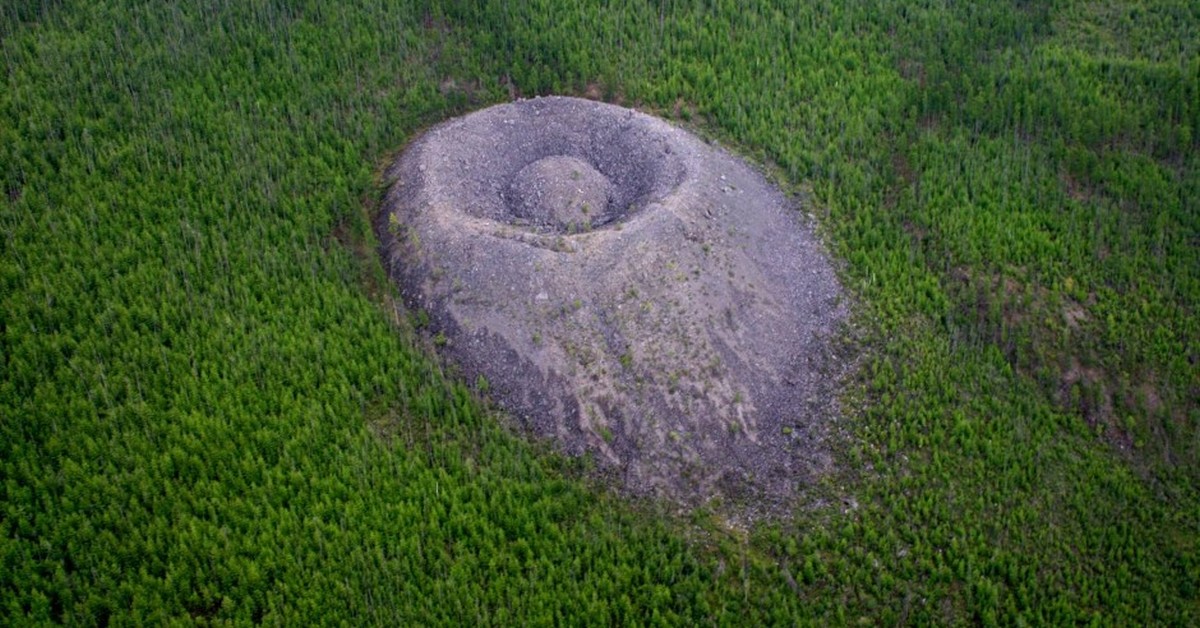It was August of 1949. Geologist Vadim Kolpakov had just heard a tale from locals about an eerie place in the woods known as the “Fire Eagle Nest.” Legends warned of illness, disappearances, and even death for those who ventured close (in 2005, the head of a mission to the crater indeed died suddenly nearby). Unfazed by the words of caution, Kolpakov climbed the hill and was shocked by what he saw from a distance.
…
The origin of the peculiar rock formation that rises from the dense taiga forest on the slopes of the Patom Highlands is still unknown 70 years later, despite several scientific expeditions and studies. It has a base diameter of about 160 meters and a height of about 40 meters. In the center of its ring-shaped cone of shattered limestone blocks, there is a smaller mound with a height of about 12 meters. Some have suggested that it was caused by a meteorite impact, a volcanic eruption or a gas pocket breakthrough. However, none of these hypotheses have been proven conclusively. The crater is estimated to be about 300 years old, based on the age of the trees growing nearby. Talking of trees… Some of them are actually unusually large and fast-growing, compared to the surrounding vegetation. In particular, scientists discovered an unusual anomaly in the annual ring formation of trees aged over 200 years. Some trees fell or broke in 1841-42, displaying concurrent narrowing of annual rings leading to their demise. The complexity deepened when analyzing tree rings near the crater. In the same year, 1842, tree rings exhibited a significant increase, maintaining a surprisingly high rate for approximately 40 years before sharply narrowing. ‘I know of only one similar case,” said Viktor Voronin, a doctor of biological sciences and head of the laboratory of the Siberian Institute of Plant Physiology and Biochemistry, who also visited the Patomskiy crater and came up with the above findings. “When, after the Chernobyl disaster due to release of radiation, the growth of trees increased dramatically. Maybe we are dealing with something similar here? Yes, now the background radiation in the crater is low. But maybe at some point of time suddenly short-lived radioactive isotopes somehow got here, which had to date, break up, and later the radioactivity decreased to natural? “A radioactive meteorite? Or, terrible to say, artificial space objects with nuclear fuel on board? There are trees that fell, and broken trees are there as well. Trees away from the crater generally grow quite inexplicably. And it happened in the same years. In general, it is a mysterious story.”
Based on the Wikipedia article, it sounds like it’s been pretty well proven to be geological in origin.
From the wiki article:
Its origins have been subject of intense scientific interest, with hypotheses including meteorite, volcanic and gaseous origin, but to date no definite proof has been given
From the further down the wiki:
A study conducted by V. S. Antipin and A. M. Fedorov showed, through morphological, structural and chemical data, that the crater is volcanic in origin. The presence of weathered breccias, the diameter/height ratio typical of volcanic cones, the absence of geochemical anomalies linked to cosmogenic origins, and its zoning of different ages, contradict clearly the meteorite hypothesis.[3] The origin of the cone is therefore volcanic, caused by a rapid outbreak of deep fluids (CO2 and H2O) and gases (CO and H2).
And
In 2010, Saint Petersburg Mining Institute held a scientific conference “Patom Crater 2010”. Viktor Sergeyevich Antipin, head of a department at the St. Petersburg Institute of Geochemistry of the Russian Academy of Sciences (IG SB RAS), stated that “Since the 2006 expedition by the Institute of Geochemistry (IGC), RAS came to the conclusion that the Patomskiy crater probably originates from geological processes. An important fact is that no serious argument or evidence of a meteorite crater nature referred to by specialists had been given. There was not any new evidence to support the meteorite hypothesis.”[citation needed] Antipin further noted that at the conference, for the first time, all the experts rejected the meteoric hypothesis. “Now it has only historical interest,” he added.
It’s funny how often “mysterious” phenomena that leave scientists “baffled” can be explained reasonably.
I mean, if I understand this correctly, they still don’t know wtf happened. They just know it was not a meteor impact.
Patom Crater Conference, 2010
In 2010, Saint Petersburg Mining Institute held a scientific conference “Patom Crater 2010”. Viktor Sergeyevich Antipin, head of a department at the St. Petersburg Institute of Geochemistry of the Russian Academy of Sciences (IG SB RAS), stated that “Since the 2006 expedition by the Institute of Geochemistry (IGC), RAS came to the conclusion that the Patomskiy crater probably originates from geological processes. An important fact is that no serious argument or evidence of a meteorite crater nature referred to by specialists had been given. There was not any new evidence to support the meteorite hypothesis.”[citation needed] Antipin further noted that at the conference, for the first time, all the experts rejected the meteoric hypothesis. “Now it has only historical interest,” he added.[citation needed]
According to studies by Siberian scientists, the crater formed only 300 to 350 years ago.[citation needed] The zoning of the crater was caused by geological processes and intensive introduction of deep gas flows of matter, which led to the transformation of silicate rocks within the crater.[citation needed] “An important confirmation of these ideas were the result of geophysics from Saint Petersburg Mining University and Yekaterinburg [Institute of Geophysics, UB RAS]. Performing gravimetric and geoelectrical investigations, they also came to the firm conviction that Patom crater has an origin of an endogenetic nature,” said Antipin.[citation needed] According to geophysicists of St. Petersburg and Yekaterinburg, meteorite impact craters have a very different shape, and Patom crater is not one of them, he added.[citation needed]

The universe is under no obligation to make sense to us.
the Earth got hit by a stray round from a star cruiser in some interstellar conflict
I thought about this whilst watching The Expanse. Rail gun rounds popping here there and everywhere. At some point they’ll hit something they can’t just zip through, maybe hundreds of years after firing. Small chance they’d hit a planet (probably burn up in atmosphere) but what about something like the Moon with little to no atmosphere? I obviously have too much time on my hands ;-)
Maybe, but try hundreds of millions of years after firing. Space is big.
Wouldn’t that be a piece of luck? Your race is just making it’s first journeys off the surface of it’s home planet. And BLAP! a stray rail gun round round fired light years away, when your kind were just making their way out of the primordial ooze takes out your ship.
As mass effect taught us, Newton is the deadliest son-of-a-bitch in space.
THAT, IS WHY WE DON’T FIRE FROM THE HIP!
YOU PULL THAT TRIGGER AND YOU ARE RUINING SOMEONE’S DAY SOMEWHERE
I mean that’s pretty clearly a cinder cone, right?
It’s 2023 and people STILL feel the need to believe in bullshit.
I mean the crater definitely exists and it is weird. Are you talking about the extraterrestrial space ship hypothesis? Thats a little out there, for sure, but it’s just conjecture. I don’t think it’s hurting anyone.
Just the entire “mysteries of the enigma!” nonsense that surrounds things like this. Everyone is always trying to make something out of nothing.
So what is it then?
Here you go, bud
https://kbin.social/m/forteana@feddit.uk/t/657923/-/comment/3791365
That link just takes me to a login page
Took me to a comment in this thread explaining the phenomena. It’s been taken from the wiki for the crater.
It’s a crater. Nothing special. A crater. No magic, no mystery- just simply…. a crater.
And the Grand Canyon is just a hole in the ground… yes it’s obvious enough that it’s a fucking crater.
It’s the answer to what formed the crater that is interesting, the thing that peaks human curiosity, the answers to why.
You’re clearly not the type of person that thinks the dumb shit I’m referring to, so… why are you responding?
I don’t think the dumb shit?
What?
It looks like a HRT, but it was denied after two years in.
Hehe. Tits.
Boobs can’t be not funny. It’s their natural quality.
This is really interesting. Clearly whatever it was, was radioactive. Doesn’t necessarily mean ‘aliens’ but it’s certainly a peculiar meteorite, if that’s what it was. AFAIK while meteorites can often have radioactive elements, they are only slightly higher % than in natural rock formations, and certainly not enough to account for the odd / excessive tree growth.
Re the mound-on-a-mound… if a highly-radioactive meteorite crashed, and buried into the ground, could it then cause a dome to form on top of the rubble? Could 300+ years of weathering make the dome nice and smooth? Another possibility is volcanism, looks kinda like what you’d get with a capped volcano. The increased localised heat might also be an explanation for the increased growth of the trees… or would excess heat in the ground just kill the trees?
Nitrogen-rich ash from eruption would explain the broken trees and increase in growth. As the new, rich soil was depleted, growth would return to normal (as seen). Just my guess, I am by no means an expert.
Yeah, volcanism definitely seems the most likely reason for the dome, like you I’m not a biologist so was hoping someone would chime in re the temps… didn’t consider nitrogen ash though, good point.









